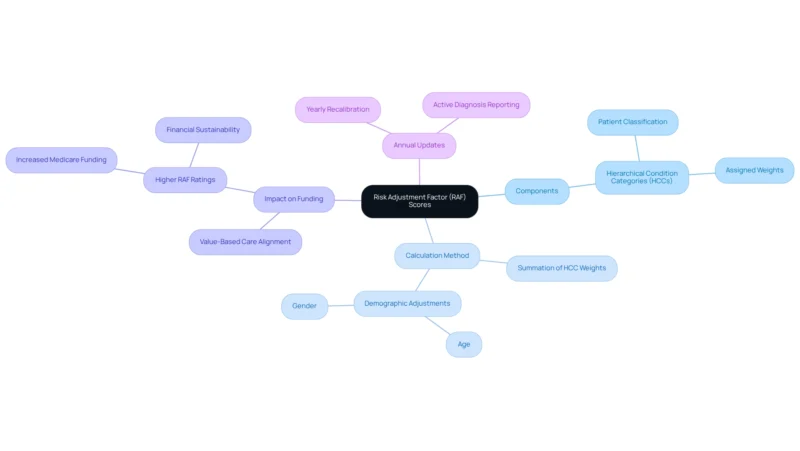
Overview
This article delves into the pivotal changes and coding strategies linked to CMS-HCC version 28, which profoundly influences risk adjustment in Medicare. It underscores the expansion of HCC categories and reduction in the number of ICD-10 codes eligible for risk adjustment as a significant development, highlighting the imperative for precise documentation and the adoption of advanced coding technologies. These elements are essential for healthcare providers aiming to optimize reimbursement and adeptly navigate the complexities introduced by this new model.
Introduction
In the intricate realm of healthcare reimbursement, a comprehensive understanding of Hierarchical Condition Categories (HCC) is paramount for providers navigating the complexities of Medicare’s risk adjustment landscape. These categories are instrumental in shaping payment structures based on the severity of patients’ health conditions, underscoring the necessity for precise coding and documentation to achieve financial success.
With the recent transition to CMS-HCC Version 28, which broadens the spectrum of categories and introduces new challenges, healthcare organizations must recalibrate their strategies to ensure compliance and optimize reimbursement.
This article examines the critical importance of HCCs, investigates the transformations enacted by Version 28, and delineates best practices that providers can implement to excel in this dynamic environment.
Define Hierarchical Condition Categories (HCC) and Their Role in Medicare Risk Adjustment
Hierarchical Condition Categories (HCC), particularly cms-hcc version 28, serve as a vital risk adjustment model utilized by the Centers for Medicare & Medicaid Services (CMS) to project future medical expenses based on patients’ health conditions. Each HCC is linked to a specific set of diagnoses, meticulously organized to reflect the severity and complexity of a patient’s health status. This model assigns a Risk Adjustment Factor (RAF) score to each patient, which plays a crucial role in adjusting payments to healthcare providers, ensuring fair compensation for the care of patients with diverse health needs.
The significance of HCCs in Medicare reimbursement is paramount. Best practices advocate for comprehensive documentation and recording of health status for all Medicare beneficiaries, irrespective of attribution. This diligent approach not only enhances coding accuracy but also maximizes reimbursement potential. Inferscience’s Claims Assistant conducts a gap analysis on claims files to identify HCC codes that may have been overlooked, ensuring that providers can submit all appropriate codes. This capability provides plans and Medicare with a more accurate understanding of the patient’s condition and anticipated healthcare expenditures.
Expert insights further underscore the importance of HCCs in navigating the complexities of Medicare reimbursement. As Karen G. Youmans, President of YES HIM Consulting, Inc., articulates, “If the CMS risk adjustment model sounds too complicated, consider hiring an HCC RA Coding Specialist to correctly code charts, accurately identify patients’ risk scores, and help save revenue for the healthcare organization.” This perspective reinforces the need for specialized knowledge in HCC classification to enhance financial outcomes.
Moreover, the impact of HCC classification on Medicare reimbursement rates is profound. Accurate coding directly influences RAF scores, which in turn affect funding amounts for healthcare organizations. Inferscience’s HCC Assistant, leveraging advanced Natural Language Processing (NLP), automates HCC code suggestions in real time, enabling providers to swiftly accept or reject them based on their expert judgment. The HCC Assistant helps with accurate documentation for risk adjustment and eliminates nearly all manual effort in workflow processes, significantly enhancing efficiency. As the CMS-HCC version 28 continues to refine its risk adjustment methodologies, stakeholders are encouraged to align their practices with the latest standards to optimize reimbursement outcomes. Furthermore, CMS has sought input on potential new measure concepts, which could further influence HCC classification practices and their ramifications for reimbursement. Current statistics reveal that successful execution of HCC classification can substantially enhance financial outcomes for medical organizations, making it a critical focus for professionals aiming to thrive in the Medicare landscape.
Explore Key Changes in CMS-HCC Version 28: Implications for Healthcare Providers
CMS-HCC Version 28 introduces several crucial changes that medical professionals must comprehend in order to navigate the evolving landscape of risk adjustment. The number of HCC categories has expanded significantly from 86 to 115, allowing for a more nuanced classification of health conditions. This increase necessitates a heightened focus on accurately documenting patients with multiple chronic conditions, as these individuals typically require more complex care management. The transition to CMS-HCC Version 28 will gradually be implemented over three years, with 67% of risk scores expected to be calculated using this new model by 2025. This phased approach underscores the importance of preparation and adaptation among healthcare providers. Notably, some common conditions will no longer map to a payment HCC according to CMS-HCC Version 28, which could adversely affect Risk Adjustment Factor (RAF) scores.
Expert analysis highlights that investing in technologies, such as advanced NLP tools, that improve the accuracy and efficiency of processing large volumes of clinical documents will be vital for Medicare Advantage Organizations (MAOs) and other stakeholders in managing their risk adjustment programs effectively. These tools can assist in consolidating patient data, enhancing workflows through automated data extraction and analysis, and minimizing human error, ultimately resulting in improved HCC classification accuracy and optimized Medicare Advantage funding.
Furthermore, CMS projects a -3.12% decrease in MA risk scores, resulting in a $11.0 billion net savings to the Medicare Trust Fund in 2024. This decrease highlights the importance for medical practitioners to adjust their reimbursement tactics to ensure financial sustainability. The link between this anticipated reduction and the necessity for sophisticated coding technologies is evident: without precise coding, providers risk losing essential funding.
As medical organizations adjust to these changes, case studies show that those who invest in advanced classification technologies, including Inferscience’s HCCs Assistant, are better positioned to navigate the complexities of the transition and maintain strong risk adjustment programs. For instance, the case study named ‘Challenges in Managing HCC Model Transition’ demonstrates how a medical organization effectively adopted new classification technologies to tackle the variations in HCC classifications and RAF scores, ultimately enhancing their risk adjustment results in the context of CMS-HCC Version 28. Understanding these changes is essential for ensuring compliance and optimizing reimbursement strategies in the face of evolving CMS guidelines. CFOs may have concerns regarding the transition to Version 28 and the integration of NLP tools; addressing these through targeted FAQs can provide clarity and support informed decision-making.
Implement Best Practices for HCC Coding Under Version 28: Strategies for Success
To effectively implement HCC classification under cms-hcc version 28, healthcare providers should adopt the following best practices:

Conclusion
The discourse on Hierarchical Condition Categories (HCC) and their pivotal role in Medicare risk adjustment underscores the intricate connection between coding accuracy and financial outcomes for healthcare providers. With the advent of CMS-HCC Version 28, the expanded array of categories and reduction in the number of codes which map to HCC categories demands a more meticulous approach to coding, particularly for patients with multiple chronic conditions. This progression accentuates the necessity of comprehensive documentation, continuous staff training, and the incorporation of advanced technology to refine coding processes and enhance accuracy.
Moreover, grasping the ramifications of Version 28 is essential for healthcare organizations aiming to adjust their reimbursement strategies effectively. The anticipated reduction in Medicare Advantage risk scores serves as a stark reminder of the financial implications that precise HCC coding entails. By investing in innovative coding solutions and adhering to best practices, providers can adeptly navigate these changes, ensuring compliance and maximizing their reimbursement potential.
In summary, the landscape of Medicare reimbursement is in a constant state of flux, necessitating that healthcare organizations remain vigilant and proactive. By prioritizing accurate HCC coding and harnessing technology, providers can not only bolster their financial performance but also enhance patient care. The strategic implementation of these practices will ultimately empower healthcare organizations to flourish in an increasingly complex environment.